Seat Altea XL 2010 Owner's Manual
Manufacturer: SEAT, Model Year: 2010, Model line: Altea XL, Model: Seat Altea XL 2010Pages: 312, PDF Size: 8.41 MB
Page 271 of 312
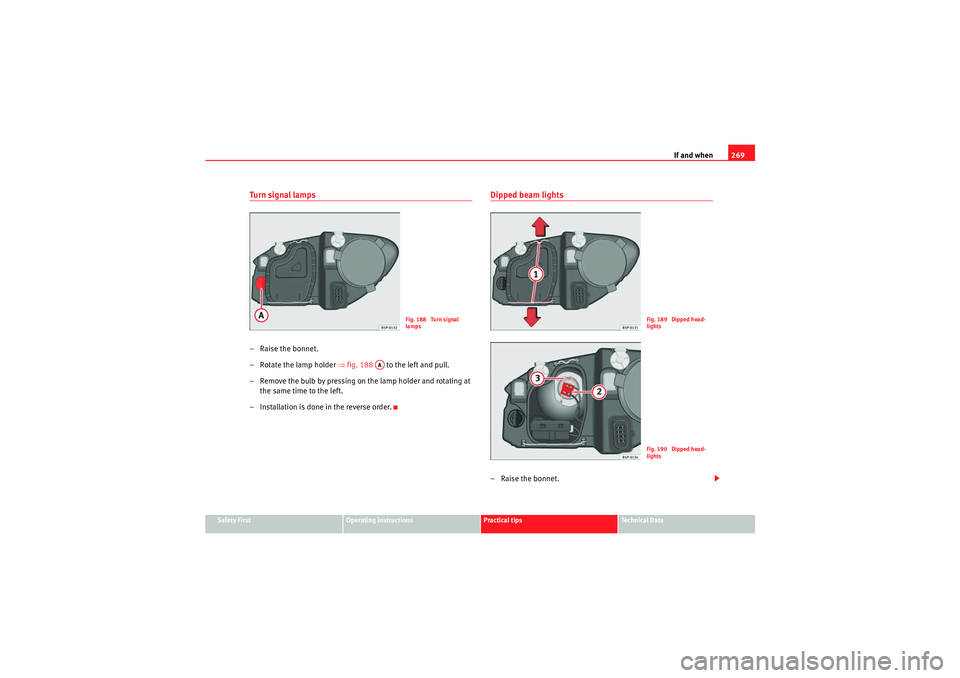
If and when269
Safety First
Operating instructions
Practical tips
Technical Data
Turn signal lamps– Raise the bonnet.
– Rotate the lamp holder ⇒ fig. 188 to the left and pull.
– Remove the bulb by pressing on the lamp holder and rotating at the same time to the left.
– Installation is done in the reverse order.
Dipped beam lights– Raise the bonnet.
Fig. 188 Turn signal
lamps
AA
Fig. 189 Dipped head-
lightsFig. 190 Dipped head-
lights
AlteaXL_EN.book Seite 269 Dienstag, 1. September 2009 10:37 10
Page 272 of 312
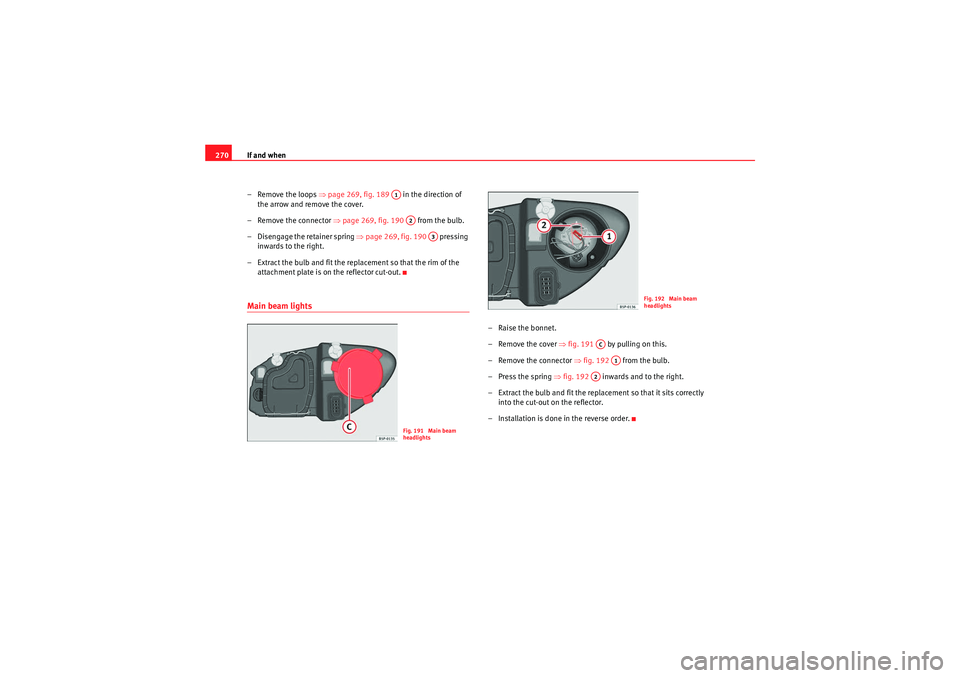
If and when
270
– Remove the loops ⇒page 269, fig. 189 in the direction of
the arrow and remove the cover.
– Remove the connector ⇒page 269, fig. 190 from the bulb.
– Disengage the retainer spring ⇒page 269, fig. 190 pressing
inwards to the right.
– Extract the bulb and fit the replacement so that the rim of the attachment plate is on the reflector cut-out.Main beam lights
– Raise the bonnet.
– Remove the cover ⇒fig. 191 by pulling on this.
– Remove the connector ⇒fig. 192 from the bulb.
–Press the spring ⇒fig. 192 inwards and to the right.
– Extract the bulb and fit the replacement so that it sits correctly into the cut-out on the reflector.
– Installation is done in the reverse order.
A1
A2
A3
Fig. 191 Main beam
headlights
Fig. 192 Main beam
headlights
AC
A1
A2
AlteaXL_EN.book Seite 270 Dienstag, 1. September 2009 10:37 10
Page 273 of 312
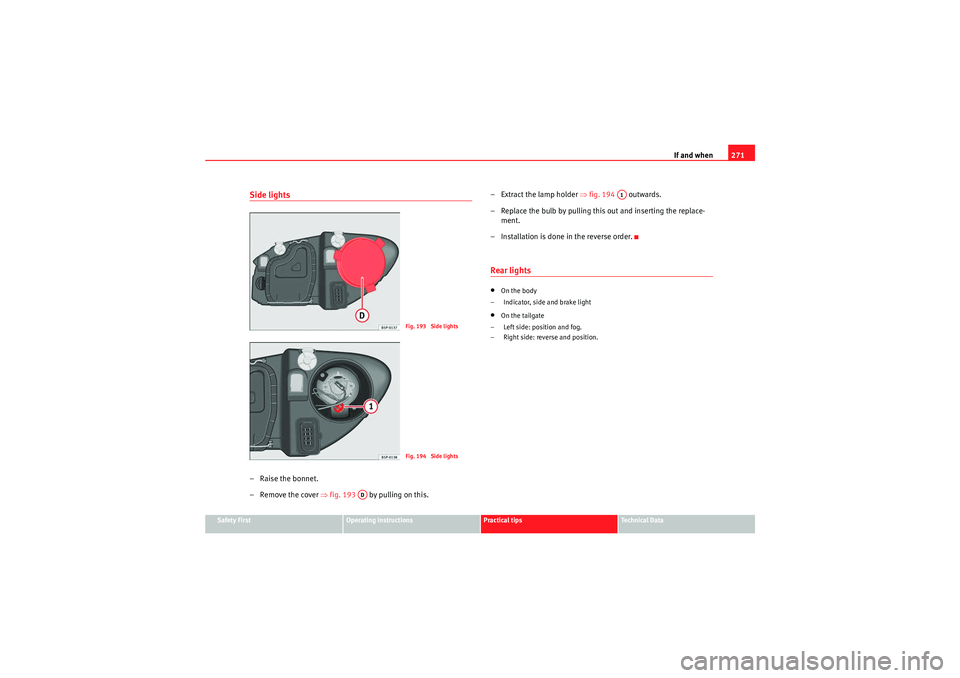
If and when271
Safety First
Operating instructions
Practical tips
Technical Data
Side lights– Raise the bonnet.
– Remove the cover ⇒fig. 193 by pulling on this. –Extract the lamp holder
⇒fig. 194 outwards.
– Replace the bulb by pulling this out and inserting the replace- ment.
– Installation is done in the reverse order.
Rear lights•On the body
– Indicator, side and brake light•On the tailgate
– Left side: position and fog.
– Right side: reverse and position.
Fig. 193 Side lightsFig. 194 Side lights
AD
A1
AlteaXL_EN.book Seite 271 Dienstag, 1. September 2009 10:37 10
Page 274 of 312
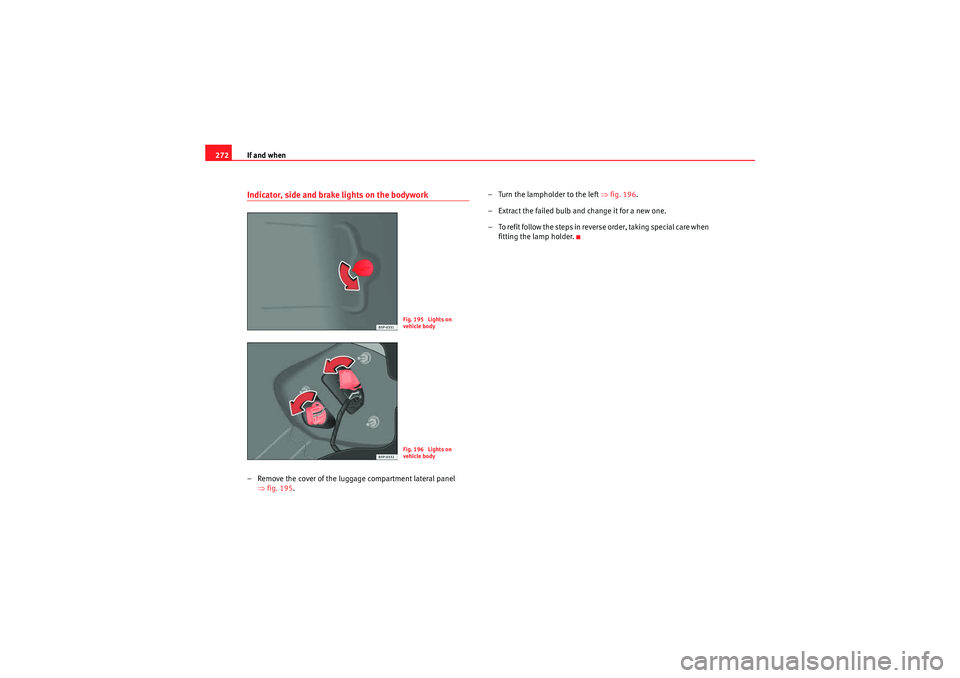
If and when
272Indicator, side and brake lights on the bodywork– Remove the cover of the luggage compartment lateral panel
⇒fig. 195 . – Turn the lampholder to the left
⇒fig. 196.
– Extract the failed bulb and change it for a new one.
– To refit follow the steps in reverse order, taking special care when fitting the lamp holder.
Fig. 195 Lights on
vehicle bodyFig. 196 Lights on
vehicle body
AlteaXL_EN.book Seite 272 Dienstag, 1. September 2009 10:37 10
Page 275 of 312
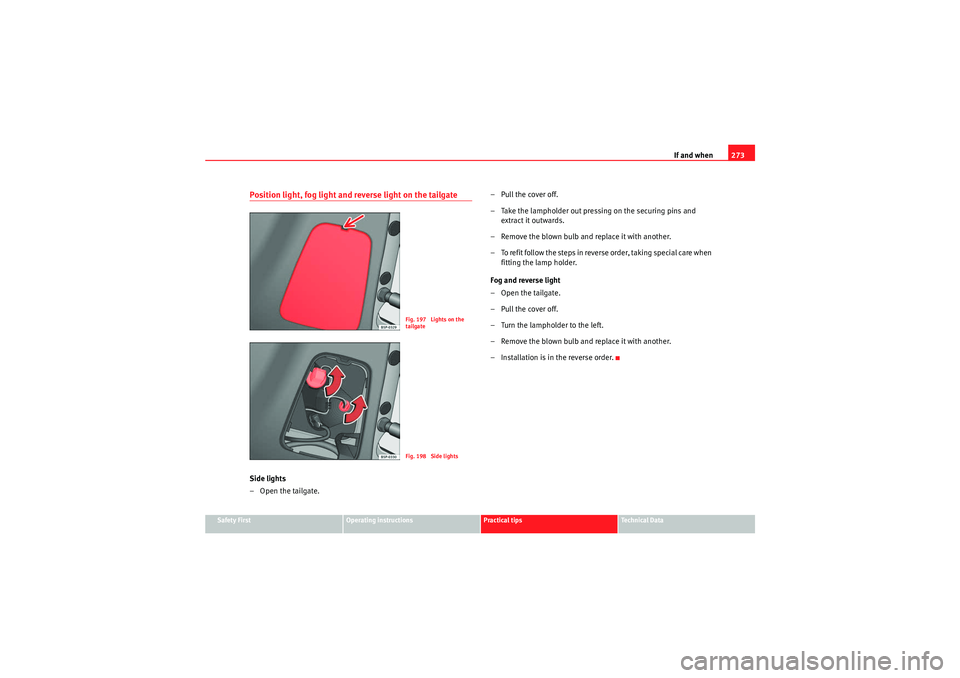
If and when273
Safety First
Operating instructions
Practical tips
Technical Data
Position light, fog light and reverse light on the tailgateSide lights
–Open the tailgate. –Pull the cover off.
– Take the lampholder out pressing on the securing pins and
extract it outwards.
– Remove the blown bulb and replace it with another.
– To refit follow the steps in reverse order, taking special care when fitting the lamp holder.
Fog and reverse light
–Open the tailgate.
–Pull the cover off.
– Turn the lampholder to the left.
– Remove the blown bulb and replace it with another.
– Installation is in the reverse order.
Fig. 197 Lights on the
tailgateFig. 198 Side lights
AlteaXL_EN.book Seite 273 Dienstag, 1. September 2009 10:37 10
Page 276 of 312
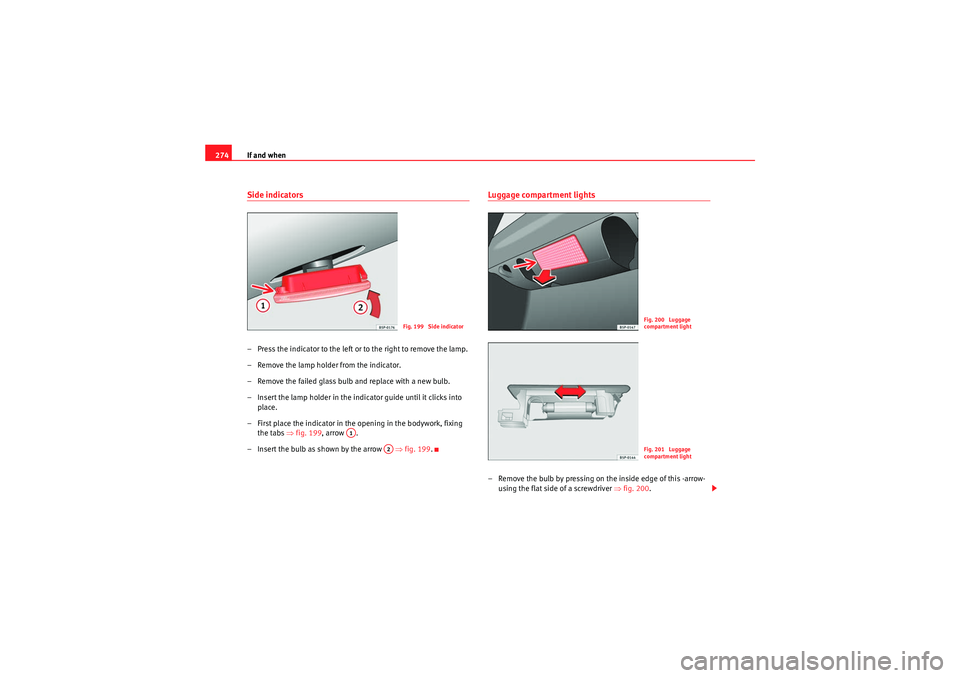
If and when
274Side indicators– Press the indicator to the left or to the right to remove the lamp.
– Remove the lamp holder from the indicator.
– Remove the failed glass bulb and replace with a new bulb.
– Insert the lamp holder in the indicator guide until it clicks into
place.
– First place the indicator in the opening in the bodywork, fixing the tabs ⇒fig. 199 , arrow .
– Insert the bulb as shown by the arrow ⇒fig. 199 .
Luggage compartment lights– Remove the bulb by pressing on the inside edge of this -arrow-
using the flat side of a screwdriver ⇒fig. 200.
Fig. 199 Side indicator
A1
A2
Fig. 200 Luggage
compartment lightFig. 201 Luggage
compartment light
AlteaXL_EN.book Seite 274 Dienstag, 1. September 2009 10:37 10
Page 277 of 312
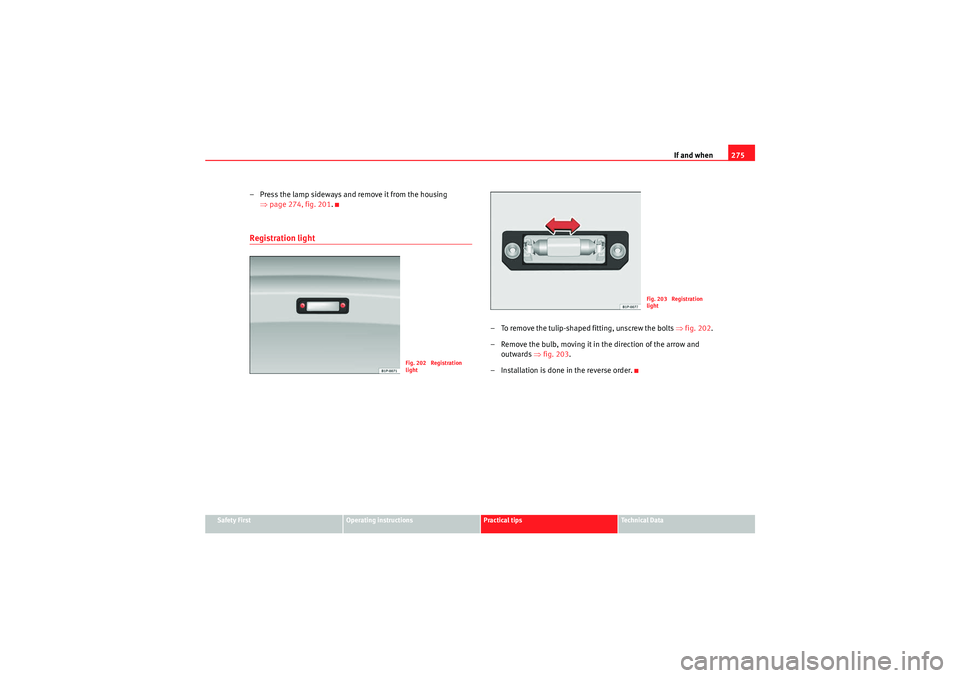
If and when275
Safety First
Operating instructions
Practical tips
Technical Data
– Press the lamp sideways and remove it from the housing
⇒page 274, fig. 201 .Registration light
– To remove the tulip-shaped fitting, unscrew the bolts ⇒fig. 202 .
– Remove the bulb, moving it in the direction of the arrow and outwards ⇒fig. 203 .
– Installation is done in the reverse order.
Fig. 202 Registration
light
Fig. 203 Registration
light
AlteaXL_EN.book Seite 275 Dienstag, 1. September 2009 10:37 10
Page 278 of 312
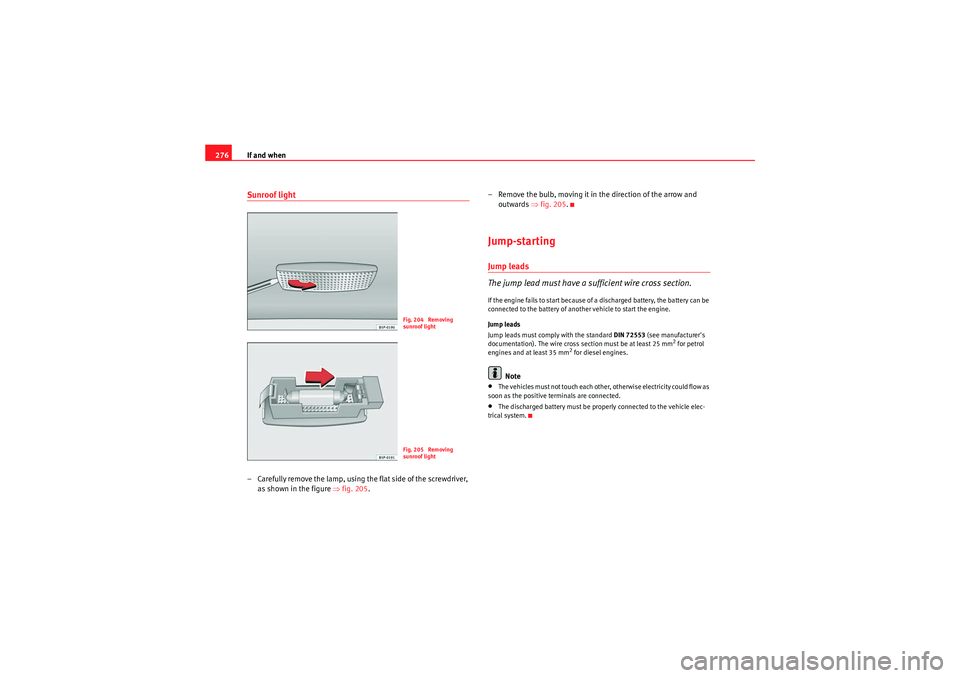
If and when
276Sunroof light– Carefully remove the lamp, using the flat side of the screwdriver,
as shown in the figure ⇒fig. 205 . – Remove the bulb, moving it in the direction of the arrow and
outwards ⇒fig. 205 .
Jump-startingJump leads
The jump lead must have a sufficient wire cross section.If the engine fails to start because of a discharged battery, the battery can be
connected to the battery of another vehicle to start the engine.
Jump leads
Jump leads must comply with the standard DIN 72553 (see manufacturer's
documentation). The wire cross section must be at least 25 mm
2 for petrol
engines and at least 35 mm
2 for diesel engines.
Note
•The vehicles must not touch each other, otherwise electricity could flow as
soon as the positive terminals are connected.•The discharged battery must be properly connected to the vehicle elec-
trical system.
Fig. 204 Removing
sunroof lightFig. 205 Removing
sunroof light
AlteaXL_EN.book Seite 276 Dienstag, 1. September 2009 10:37 10
Page 279 of 312
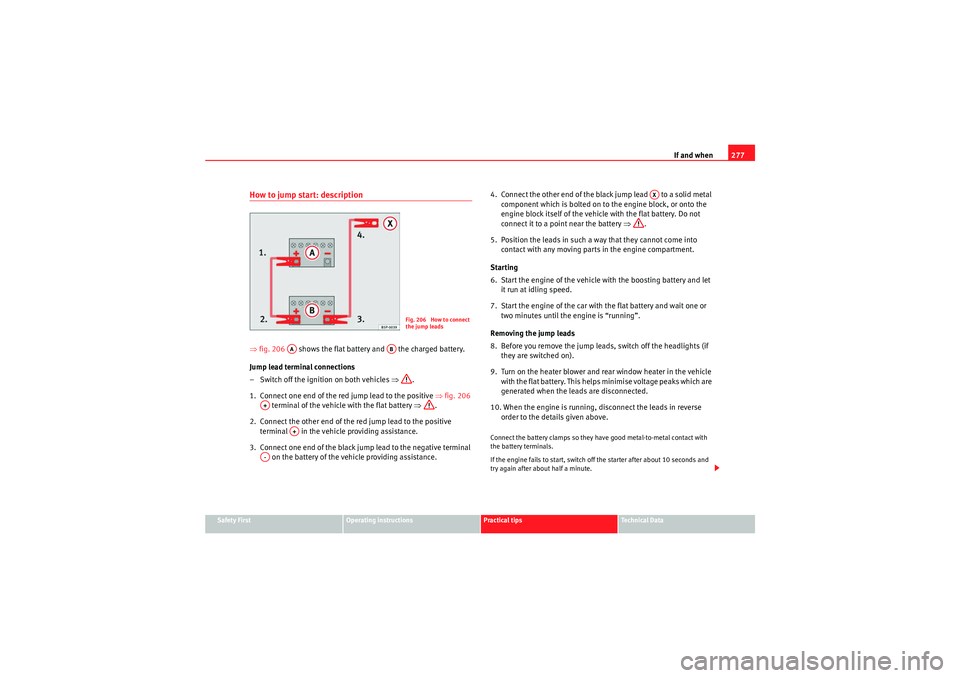
If and when277
Safety First
Operating instructions
Practical tips
Technical Data
How to jump start: description⇒fig. 206 shows the flat battery and the charged battery.
Jump lead terminal connections
– Switch off the ignition on both vehicles ⇒.
1. Connect one end of the red jump lead to the positive ⇒fig. 206
terminal of the vehicle with the flat battery ⇒.
2. Connect the other end of the red jump lead to the positive terminal in the vehicle providing assistance.
3. Connect one end of the black jump lead to the negative terminal on the battery of the vehicle providing assistance. 4. Connect the other end of the black jump lead to a solid metal
component which is bolted on to the engine block, or onto the
engine block itself of the vehicle with the flat battery. Do not
connect it to a point near the battery ⇒.
5. Position the leads in such a way that they cannot come into contact with any moving parts in the engine compartment.
Starting
6. Start the engine of the vehicle with the boosting battery and let it run at idling speed.
7. Start the engine of the car with the flat battery and wait one or two minutes until the engine is “running”.
Removing the jump leads
8. Before you remove the jump leads, switch off the headlights (if they are switched on).
9. Turn on the heater blower and rear window heater in the vehicle with the flat battery. This helps minimise voltage peaks which are
generated when the leads are disconnected.
10. When the engine is running, disconnect the leads in reverse order to the details given above.
Connect the battery clamps so they have good metal-to-metal contact with
the battery terminals.
If the engine fails to start, switch off the starter after about 10 seconds and
try again after about half a minute.
Fig. 206 How to connect
the jump leads
AA
AB
A+
A+
A-
AX
AlteaXL_EN.book Seite 277 Dienstag, 1. September 2009 10:37 10
Page 280 of 312
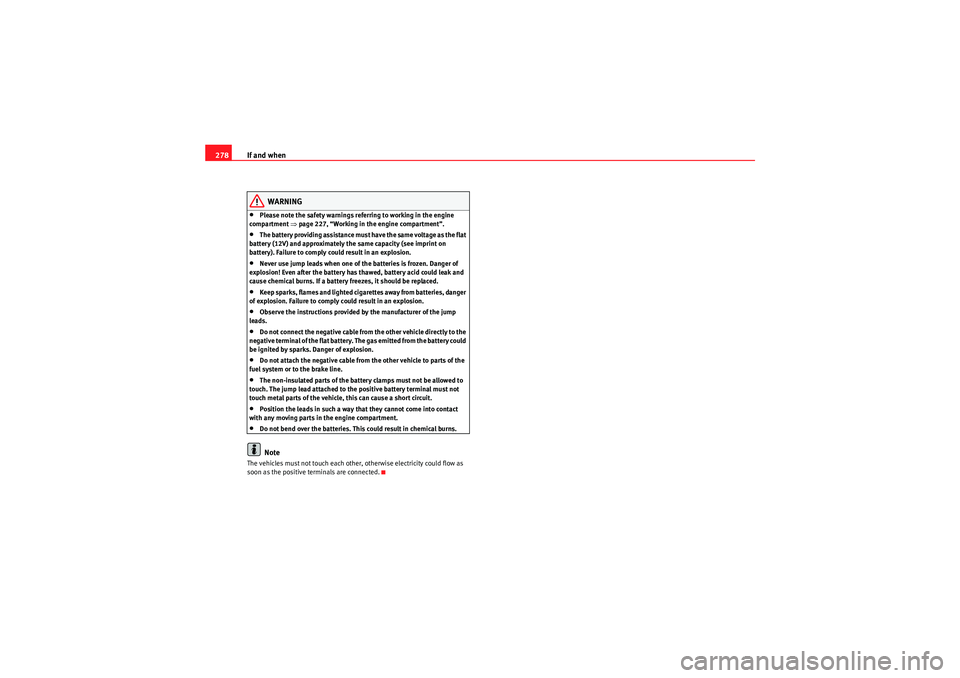
If and when
278
WARNING
•Please note the safety warnings referring to working in the engine
compartment ⇒page 227, “Working in the engine compartment”.•The battery providing assistance must have the same voltage as the flat
battery (12V) and approximately the same capacity (see imprint on
battery). Failure to comply could result in an explosion.•Never use jump leads when one of the batteries is frozen. Danger of
explosion! Even after the battery has thawed, battery acid could leak and
cause chemical burns. If a battery freezes, it should be replaced.•Keep sparks, flames and lighted cigarettes away from batteries, danger
of explosion. Failure to comply could result in an explosion.•Observe the instructions provided by the manufacturer of the jump
leads.•Do not connect the negative cable from the other vehicle directly to the
negative terminal of the flat battery. The gas emitted from the battery could
be ignited by sparks. Danger of explosion.•Do not attach the negative cable from the other vehicle to parts of the
fuel system or to the brake line.•The non-insulated parts of the battery clamps must not be allowed to
touch. The jump lead attached to the positive battery terminal must not
touch metal parts of the vehicle, this can cause a short circuit.•Position the leads in such a way that they cannot come into contact
with any moving parts in the engine compartment.•Do not bend over the batteries. This could result in chemical burns.Note
The vehicles must not touch each other, otherwise electricity could flow as
soon as the positive terminals are connected.
AlteaXL_EN.book Seite 278 Dienstag, 1. September 2009 10:37 10